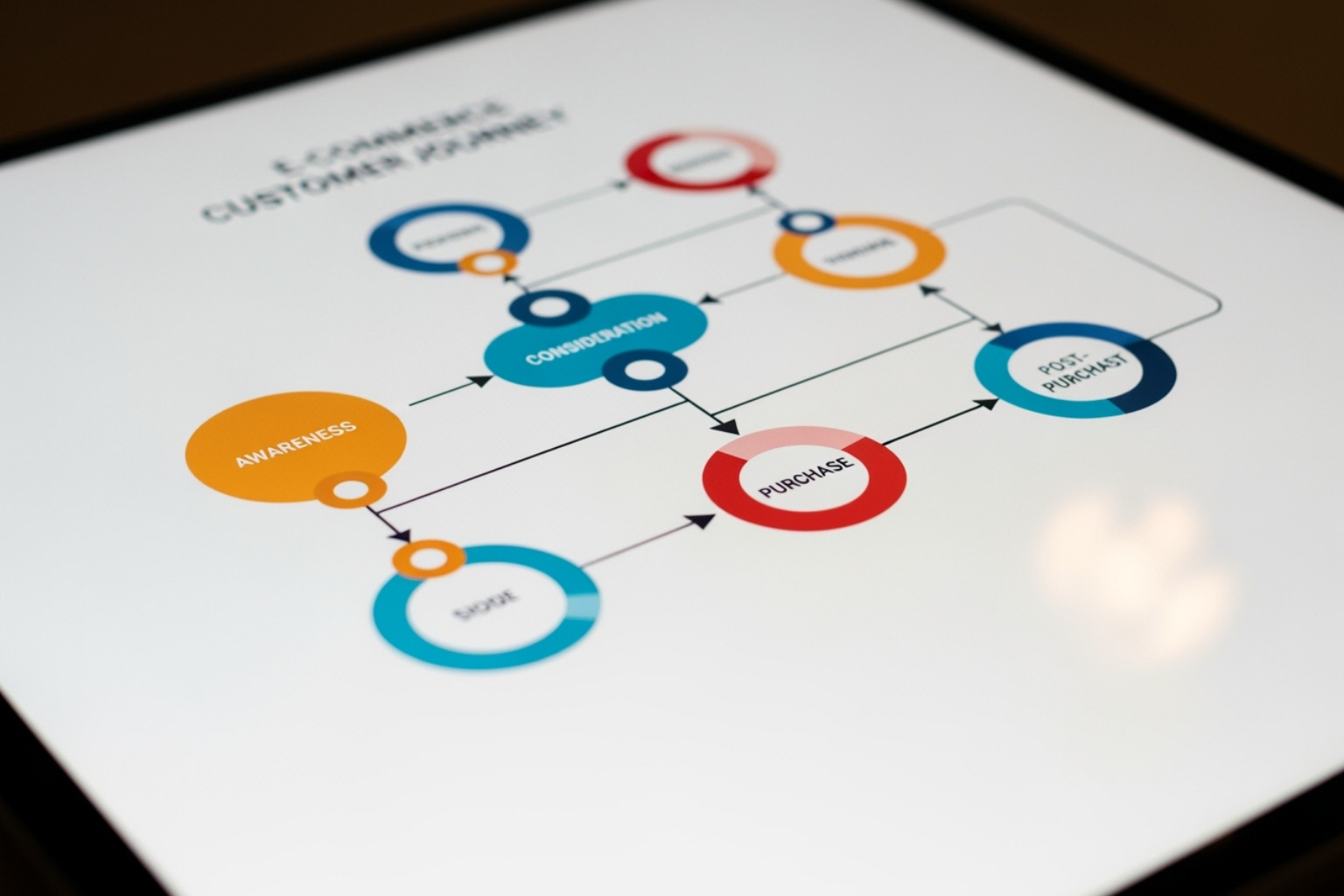Why Understanding Your Customer's Path Matters More Than Ever
Ecommerce customer journey mapping is the process of visualizing every step your customers take when interacting with your online store, from first finding your brand to becoming loyal advocates. Here's what you need to know:
Key Components of Ecommerce Customer Journey Mapping:
- 5 Main Stages: Awareness, Consideration, Acquisition, Retention, and Advocacy
- Customer Touchpoints: Every interaction point between customer and brand
- Pain Points: Friction areas that cause customers to abandon their purchase
- Data Sources: Both quantitative (analytics) and qualitative (surveys, interviews) insights
- Visual Map: A diagram showing customer actions, emotions, and experiences at each stage
Did you know that around 70% of products added to shopping carts are eventually abandoned? This statistic highlights a key issue many online store owners face. The difference between a successful ecommerce business and one that struggles often comes down to understanding why customers behave the way they do.
When you can see your store through your customer's eyes—their frustrations with a slow checkout, their confusion about product details, or their delight with fast shipping—you can fix problems before they cost you sales. Among high-performing marketing teams, 88% say a customer journey strategy is critical to their overall marketing success.
The reality is simple: customers who have smooth, personalized experiences are more likely to complete purchases and return. Those who hit roadblocks will likely click away to your competitors.
I'm Steve Pogson. With over two decades of experience scaling Shopify stores, I've seen how ecommerce customer journey mapping changes struggling businesses. My team at First Pier uses deep platform expertise and proven mapping strategies to help brands like Wyman's Blueberries and Hyperlite Mountain Gear turn customer insights into measurable growth.
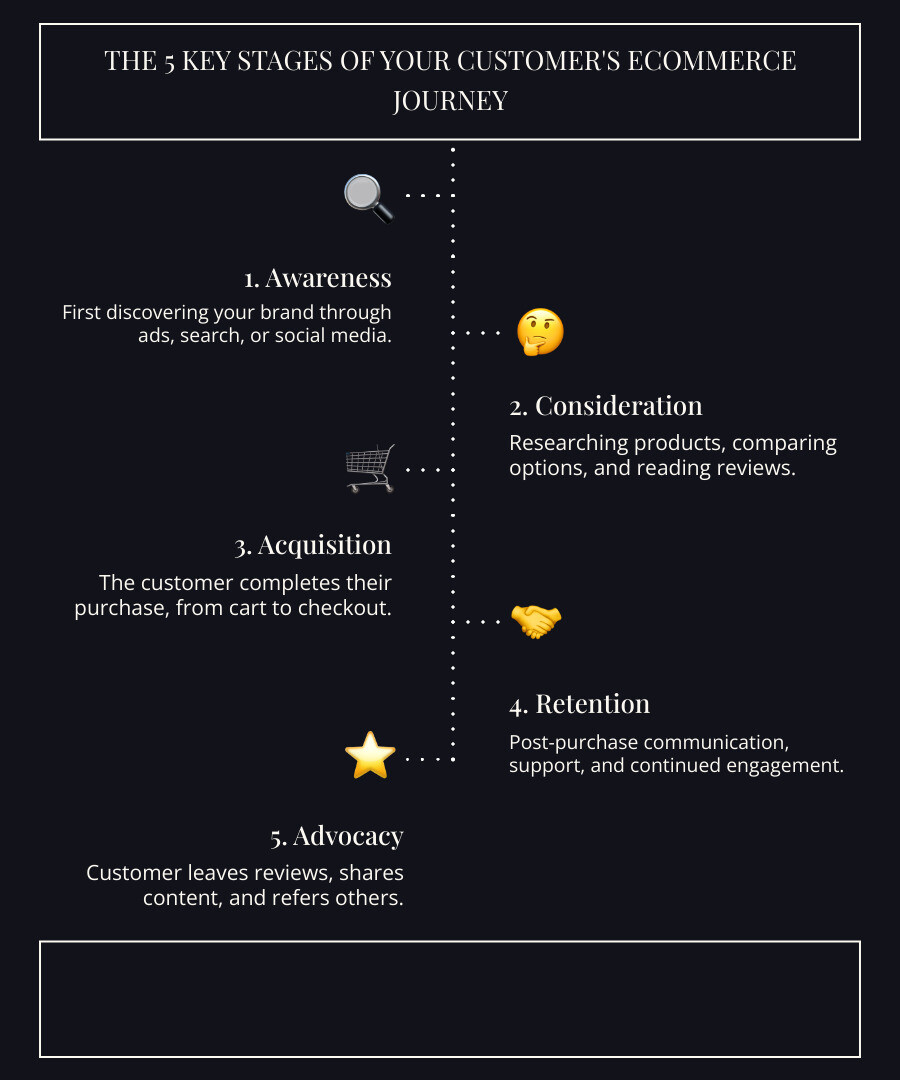
Ecommerce customer journey mapping terms made easy:
What is an Ecommerce Customer Journey Map and Why Is It Important?

An ecommerce customer journey map offers a bird's-eye view of a customer's shopping experience, from first contact to final review. This visual story shows every touchpoint, emotion, and decision. It's not just about tracking clicks; it's about understanding what customers think and feel. For example, are they excited by your product but frustrated by checkout? Your map reveals these key insights.
Why is ecommerce customer journey mapping so important?
Think of your customer experience like a chain—it's only as strong as its weakest link. One broken step can send potential buyers to your competitors, and you might never know why they left.
A better customer experience happens when you see your store through their eyes. Since 80% of customers value their experience as much as the product, this viewpoint is essential. You can spot and fix issues before they cause customers to leave.
The effect on your conversion rates can be significant. Removing friction makes it easier for customers to buy. Your map will show you exactly where and why people abandon their carts.
Customer loyalty grows when people have consistently positive experiences. Loyal customers make up 44% of a merchant's total revenue, despite being only 21% of the audience. When customers trust that shopping with you will be smooth, they keep coming back.
Your map is a great tool for spotting pain points before they cost you sales. Maybe customers dislike your shipping options or find mobile checkout confusing. Instead of guessing, you'll have clear data to guide your fixes.
This approach changes how your team works together. When everyone understands the customer's experience, they can arrange their efforts. Your marketing team will know which touchpoints matter most, and your support team will understand common frustrations.
The results speak for themselves. According to Salesforce, 88% of high-performing teams say a customer journey strategy is critical to their marketing success. These are key advantages that separate successful stores from struggling ones.
If you want to dig deeper into understanding your customers' behavior, our ecommerce analytics services can help you gather and explain the data that makes your customer journey map truly actionable.
The 5 Key Stages of the Ecommerce Customer Experience
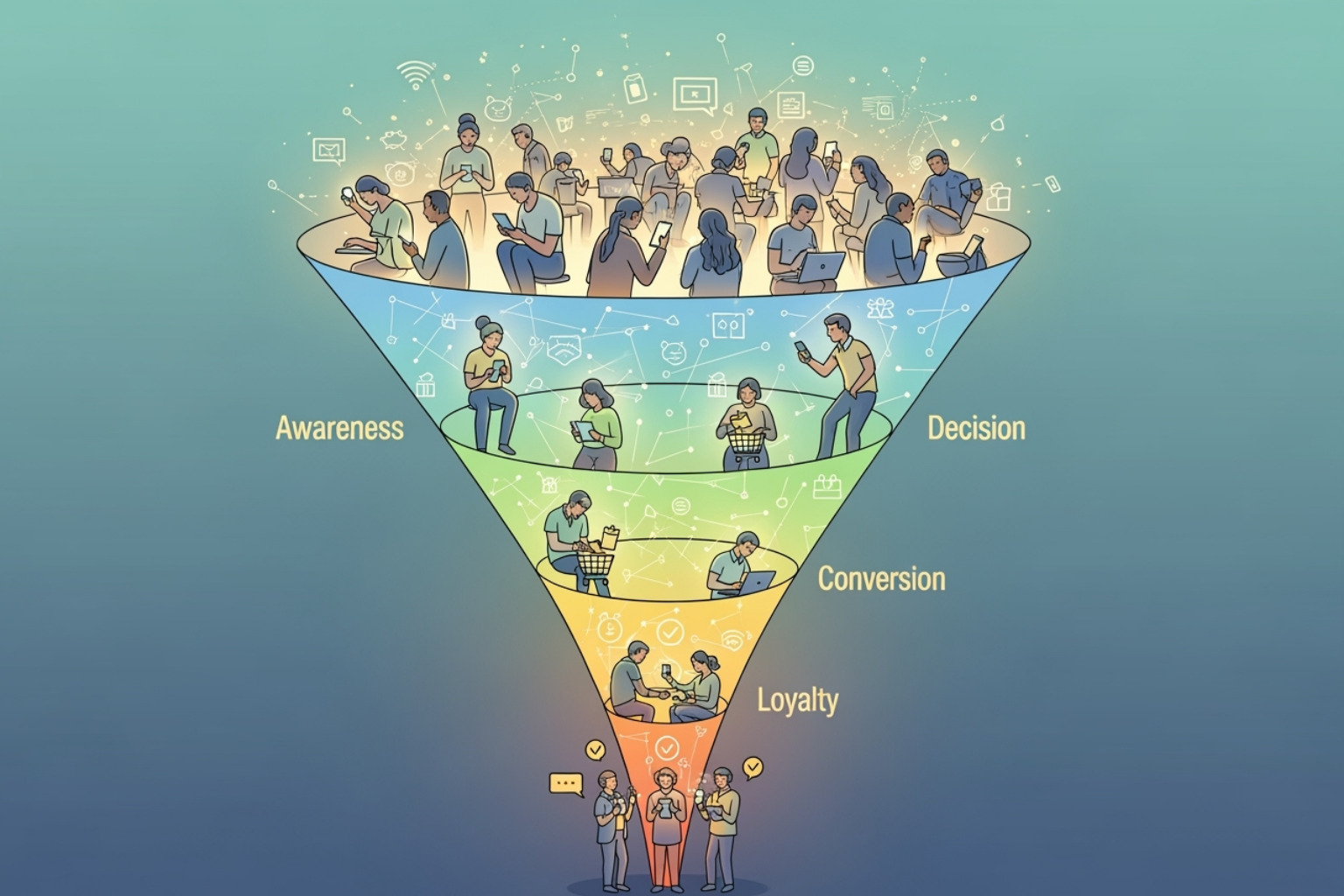
Your customer's experience has five main stages, which form the foundation of your map. Think of them as chapters in a story. Customers don't always move in a straight line; they might jump between stages. These categories just help organize the process to create a clearer picture.
1. Awareness
This is the "aha" moment when a customer realizes they have a need. They might not know your brand yet, so it's your chance to make a good first impression. Problem recognition starts it all—they need new shoes or a gift. They might find you through social media ads, blog posts, word-of-mouth, SEO, or paid search. Your goal is to get on their radar and show you have a solution. Your content should address their problems. Our paid search services can help you reach customers at this key moment.
2. Consideration
Here, the customer knows about you and is comparing you with others. They're in research mode, doing product research and comparison shopping. They're reading reviews, visiting product pages, and looking at content to help them decide. They're asking, "Is this right for me?" and "How does it compare?" A brand like Bliss World provides the detailed information customers want at this stage. Your goal is to convince them your product is the best choice. Offer clear product details, great images, and social proof like reviews to build their confidence.
3. Acquisition (Purchase)
This is the moment of purchase. The customer is ready to buy, so the process needs to be smooth. They're adding to cart, going through checkout, entering payment details, and choosing shipping options. Any friction here can lead to an abandoned cart. This is where many of the 70% of abandoned carts happen, often due to unexpected costs or a complex process. Offering trusted payment methods like Shop Pay can help, as its users are more likely to complete purchases. Your goal is a frictionless, secure, and clear path to buying. Simplify checkout, be transparent about costs, and offer multiple payment options. Our Shopify CRO services can help you improve this stage.
4. Retention
The sale isn't the end. Now, the focus is on keeping the customer happy and encouraging them to return. This stage is key for long-term success. Good post-purchase communication like order confirmations and order tracking is important. The unboxing experience, customer support, and product quality are also essential. A quick, helpful response to questions can make a huge difference. Retaining customers is much cheaper than finding new ones; a 5% boost in retention can increase profits by 25-95%. Your goal is to ensure satisfaction and build a lasting relationship. Provide great service, send follow-up emails, and create a special unboxing experience. Our email & sms marketing services can help you stay connected.
5. Advocacy
This is the final stage, where customers become brand ambassadors. They love your brand and tell others about it. They are leaving reviews, sharing user-generated content, referring friends, and joining loyalty programs. They've become true fans. The effect of this stage is huge. 81% of consumers trust recommendations from friends and family, making word-of-mouth marketing very powerful. Loyal customers may be only 21% of your audience but can make up 44% of revenue. These fans are important because they buy more and bring in new customers. Your goal is to develop a community of fans. Encourage reviews, create referral programs, and participate on social media. Our community & loyalty services can help you build these important relationships for long-term growth.
A Step-by-Step Guide to Ecommerce Customer Journey Mapping
Now that you know the stages, let's build the map. This process turns data into an actionable plan. Think of it like being a detective gathering clues. When done right, ecommerce customer journey mapping changes scattered insights into a roadmap for growth. Here’s how to create one that gets results.
Step 1: Set Clear Goals and Define Your Persona
First, set clear goals. Do you want to reduce cart abandonment or increase repeat purchases? A clear goal focuses your efforts. Pick one or two specific goals instead of trying to fix everything. Next, create a customer persona, a fictional character of your ideal customer. This is key for seeing things from their point of view, not your own. Give your persona details like a name, job, and goals, such as "Sarah, a busy mom who values fast shipping." The more specific, the better. A tool to help build your customer persona can guide you.
Step 2: List All Customer Touchpoints
A customer touchpoint is any interaction with your brand, online or offline. Brainstorm these as a team, as different departments have different perspectives. Marketing knows about social media ads and newsletters, while customer service knows about support chats. Also include smaller touchpoints like search engine results, product page visits, email confirmations, and shipping notifications. These are often opportunities to stand out. Don't aim for perfection; start with the obvious touchpoints and add more later.
Step 3: Gather and Analyze Customer Data
Base your map on real data, not guesswork. Many businesses fail here, creating maps from assumptions. Use a mix of data sources for a complete picture.
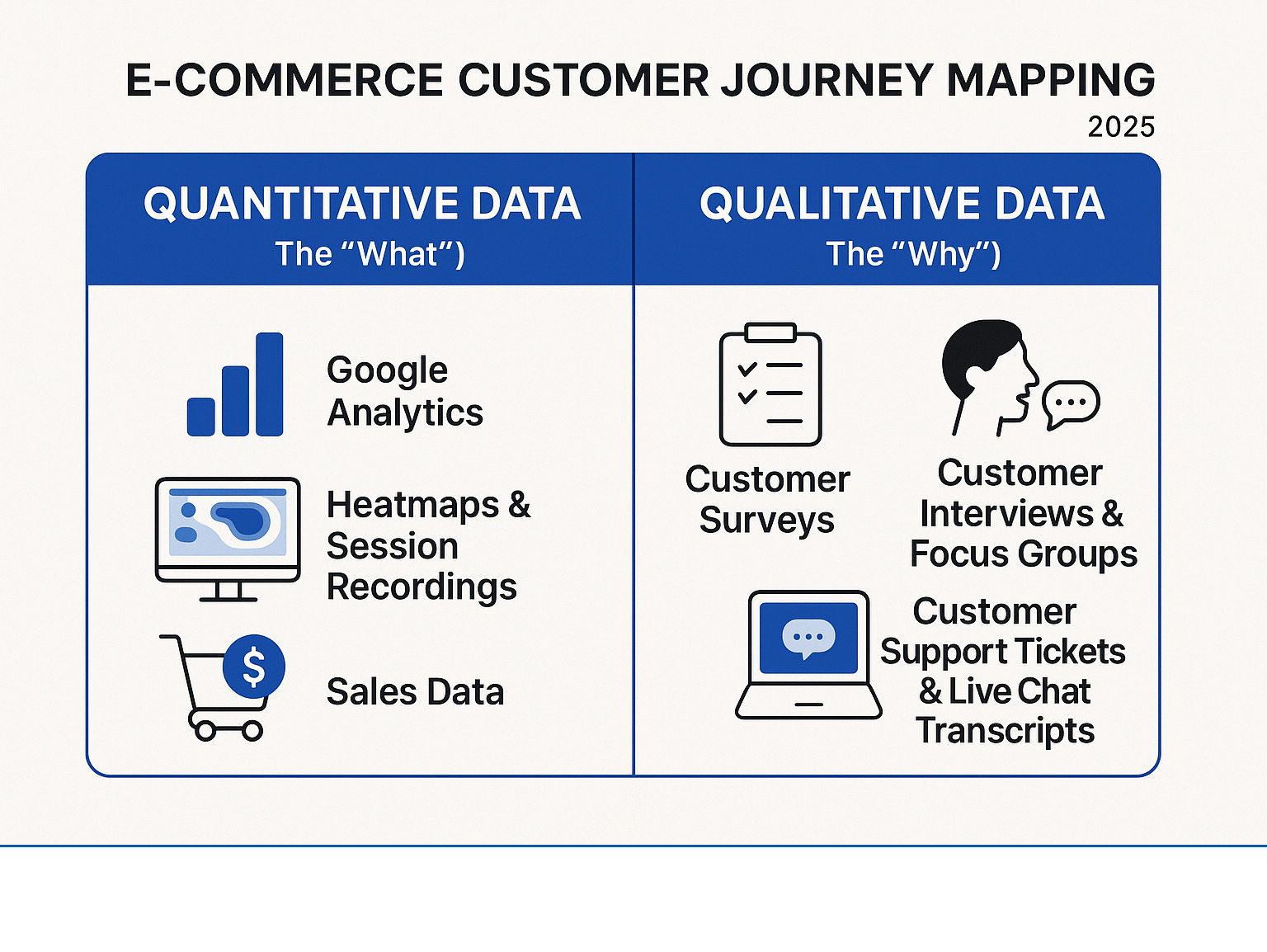
| Quantitative Data (The "What") | Qualitative Data (The "Why") |
|---|---|
| Google Analytics (e.g., path exploration report) – Shows traffic sources, conversion rates, and where users drop off. | Customer Surveys (e.g., Typeform, SurveyMonkey) – Ask customers directly about their experience, pain points, and suggestions. |
| Heatmaps & Session Recordings (e.g., HotJar) – Visualize where users click, scroll, and spend time on your site. | Customer Interviews & Focus Groups – Talk to customers face-to-face (or virtually) to understand their motivations and emotions. |
| Sales Data (Average Order Value, Customer Lifetime Value) – Reveals purchasing patterns and customer value over time. | Customer Support Tickets & Live Chat Transcripts – A goldmine for common frustrations, questions, and issues customers face. |
| Social Media Analytics – Shows engagement, reach, and sentiment towards your brand. | Online Reviews & Social Media Comments – Unsolicited feedback from customers expressing their opinions. |
Quantitative data shows what is happening (e.g., where users drop off), while qualitative data explains why (e.g., their frustrations). Gathering data is an ongoing process. The more you collect, the better your map will be. Start with what you have and keep adding to it.
Step 4: Visualize the Experience and Identify Pain Points
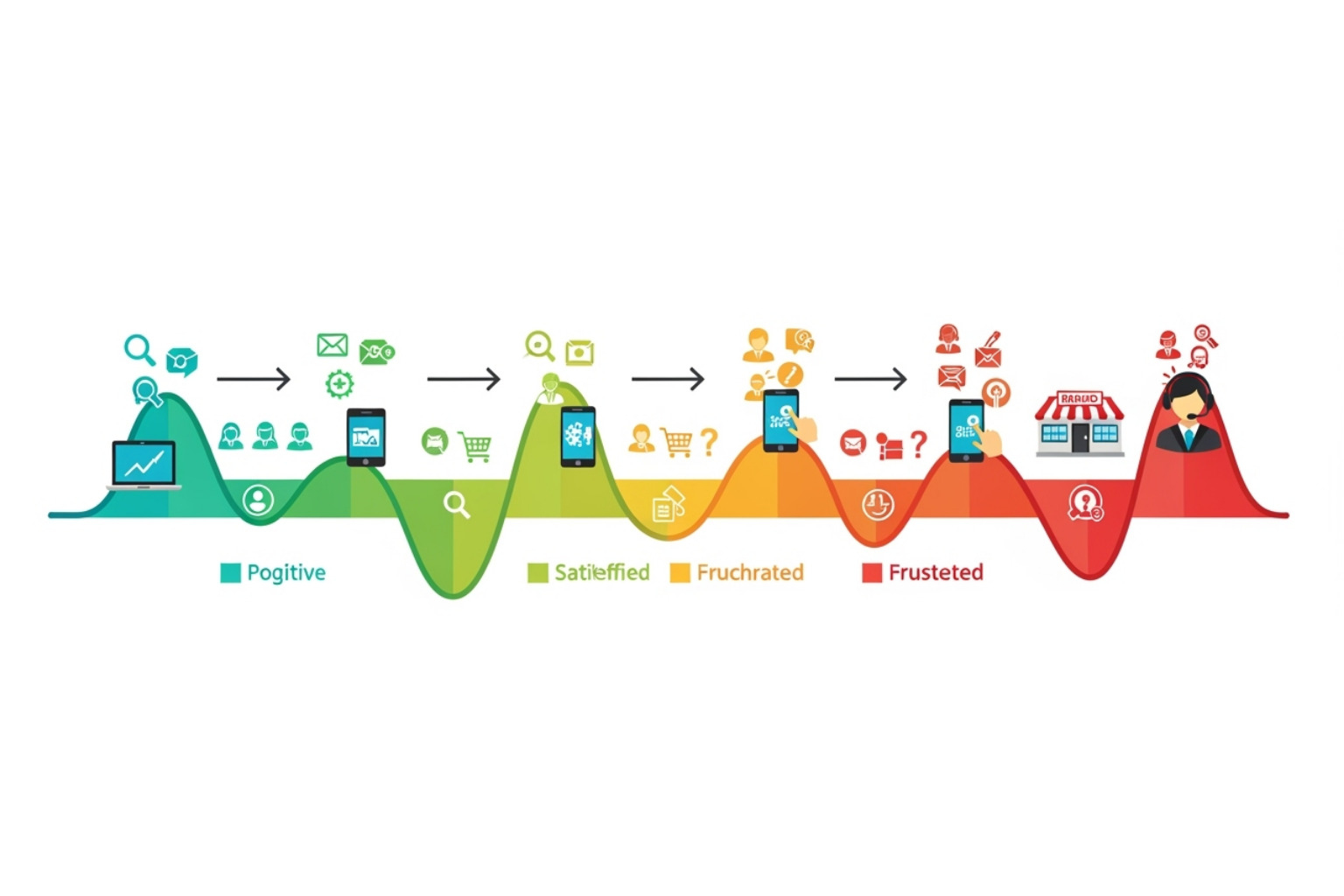
Now, build your map using a whiteboard, software, or sticky notes—the tool isn't as important as the insights. For each stage (Awareness, Consideration, Acquisition, Retention, Advocacy), plot out key elements:
- Customer Actions: What is the customer doing? (e.g., searching, clicking, adding to cart).
- Touchpoints: Where do these actions happen? (e.g., Google, product page, email).
- Thoughts & Feelings: What are they thinking and feeling? (e.g., curious, excited, frustrated). This emotional layer is key.
- Pain Points: Where do they face friction or confusion? (e.g., slow site, unclear policy). These are your opportunities for improvement.
As you fill in the map, you'll see patterns, like customers getting frustrated with shipping updates. This will show you exactly where to make changes.
Putting Your Map to Work: Improving the Customer Experience
A finished map is a powerful tool, not something to file away. Think of it as a GPS for your customer experience, showing you what to fix. The real value comes from turning these insights into real improvements that make customers happier and your business more profitable.
Improve Key Touchpoints and Reduce Friction
Start by addressing the biggest pain points your map revealed. These are the moments customers decide to stay or leave. If your map shows high cart abandonment at checkout (a common issue affecting the 70% cart abandonment rate), the fix could be simple. Offer guest checkout, show all costs upfront, or reduce the number of steps. Small changes can have a big impact, like adding reassuring text at checkout or including reviews on the product page. Removing these small irritations greatly improves the overall experience.
Personalize the Shopping Experience
Once you understand the customer's path, you can personalize their experience. This doesn't require expensive software. You can show related products based on browsing history or send follow-up emails with helpful tips. For example, if a customer looks at hiking boots, show them hiking socks. If they buy a coffee maker, send them tips for brewing coffee. This personal touch makes customers feel understood, which encourages repeat business and recommendations.
Optimize for Mobile Users
With about half of all internet traffic coming from mobile devices, a poor mobile experience can turn away many customers. Use your map to review the mobile experience step-by-step. Is it easy to browse and tap buttons on a small screen? Does checkout work smoothly? Test your site on different devices, or use Google's free mobile-friendly testing tool. Improving the mobile experience is critical, as mobile conversion rates are often low. The goal is a natural and effortless mobile site, not just a shrunken-down desktop version.
To Sum Up
Creating an ecommerce customer journey map is more than drawing a diagram; it's about understanding your customers. When you understand their full experience, from awareness to advocacy, you can see exactly where you're losing sales and where you can create great moments for them.
Your map is a living document. Review it quarterly to keep it current with customer behavior and your business. As preferences, technology, and your products develop, your map should too.
The benefits go beyond fixing problems. You'll understand what motivates customers, solve issues before they cost you sales, and build satisfaction that leads to repeat business and referrals. You'll stop guessing and start making data-based decisions.
This approach creates a customer-focused mindset in your company. Your marketing team can create better campaigns, customer service can address issues proactively, and your development team can prioritize the right site improvements.
A great customer experience becomes your competitive advantage. It's hard for others to copy because it's based on your unique understanding of your customers.
At First Pier, we specialize in creating smooth online shopping experiences that turn browsers into loyal customers. If you're ready to explore your customer's experience and make real improvements, check out our ecommerce UX design services. We'll help you build a shopping experience your customers will love.


